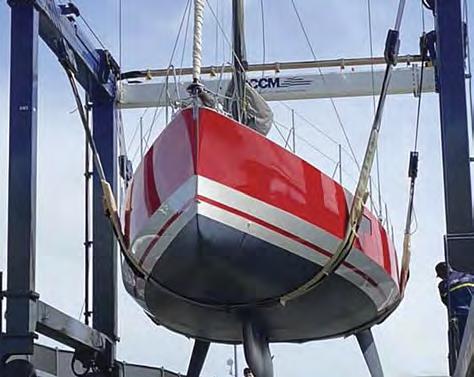
16 minute read
Nautical Training
LEARNING THE ROPES WITH A CUSTOMISED INSTRUCTION COURSE
The initial Nautical Training sessions always begin with underpinning skills and knowledge of navigation. Trip planning and forecasting are also the basis of any training day on the water and understanding weather conditions better to avoid windy weather.
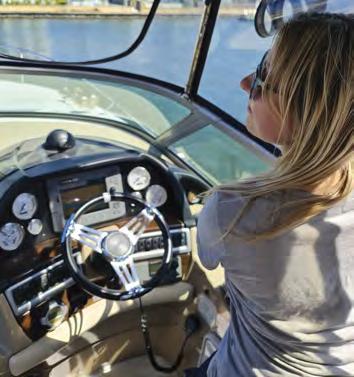
Every vessel has its own idiosyncrasies. Becoming familiar with your vessel comes with practice. Every training activity and procedure should be documented and practiced repetitively in calm conditions, until you are more confident and have a better understanding of the capabilities of your vessel and those of yourself and your crew.
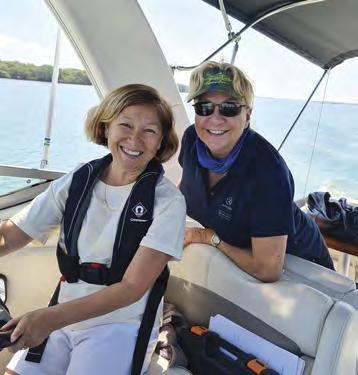
Practising emergency procedures for fire onboard, person overboard, engine failure and personal injury on a regular basis will further reduce anxiety and can ensure a far better outcome in a real-life emergency. To book a customsed training session, contact karla at www.nauticaltraining.com.au
Gulia with trainer Karla Herbert-Evans (right)
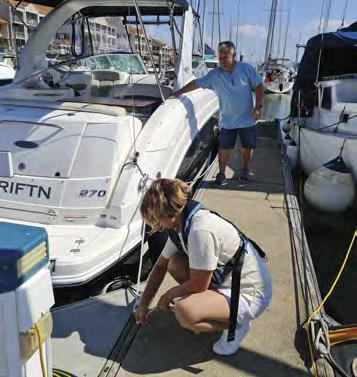
JAMES AND GULIA CARR James and Gulia booked in for their first Nautical Training session to learn more about their new Chaparral 270 Signature (2011), and about safety on the water and how to do close-quarter manoeuvring without a bow thruster. After stepping up from a jet ski, James wanted to build his confidence at the helm. Gulia had “a fear of falling in” and wanted to learn safe crew practices and gain confidence with the docking procedures. During their first training session, the VMR was called to our rescue, giving the couple the opportunity to run through some valuable emergency procedures resulting from a minor engine fault.
TRAINING SESSIONS ON: vessel familiarisation, trip planning, knots lines and hitches, manoeuvring the boat, docking, anchoring, navigating from Hope Harbour to Tipplers and back.
HIGHLIGHTS: Understanding and finessing throttle control; investigating a few alternatives for sequencing the dock lines; and agreeing on a procedure that works best for our boat, marina berth and personal capabilities.
VMR Southport called for assistance with minor engine problem during nautical training session
Missy at the helm of her sports cruiser
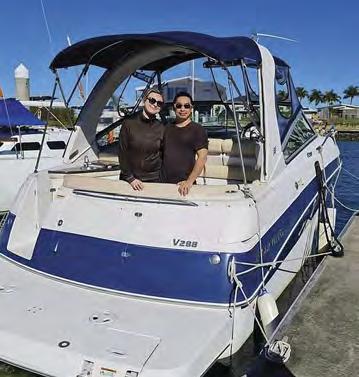
DOMINIC CHOI AND MISSY HOLC
Dominic and Missy booked their training sessions to familiarise themselves with their first boat purchase, a Four Winns V288 Twin, and to gain confidence in all aspects of boat ownership particularly in docking. The training sessions were conducted at Marina Quays, Wave Break Island, Gold Coast Seaway, and The Spit. They greatly appreciated Karla’s knowledge of all aspects of seamanship, as well as her local knowledge of the Gold Coast waterways, which they consider invaluable to a beginner.
TRAINING SESSIONS ON: vessel familiarisation, trip planning, knots lines and hitches, close-quarter manoeuvring, docking, anchoring, navigating the southern Broadwater and bar crossing, including provision of comprehensive training materials.
HIGHLIGHTS: Gaining confidence with each lesson in using the boat safely
CHALLENGES: Docking our vessel into our berth with adverse wind and currents.
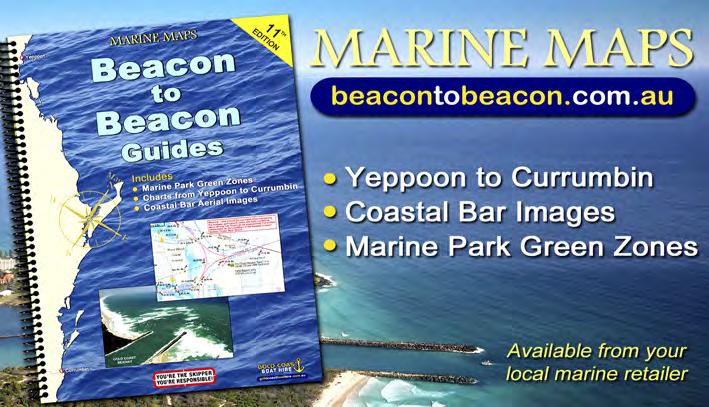
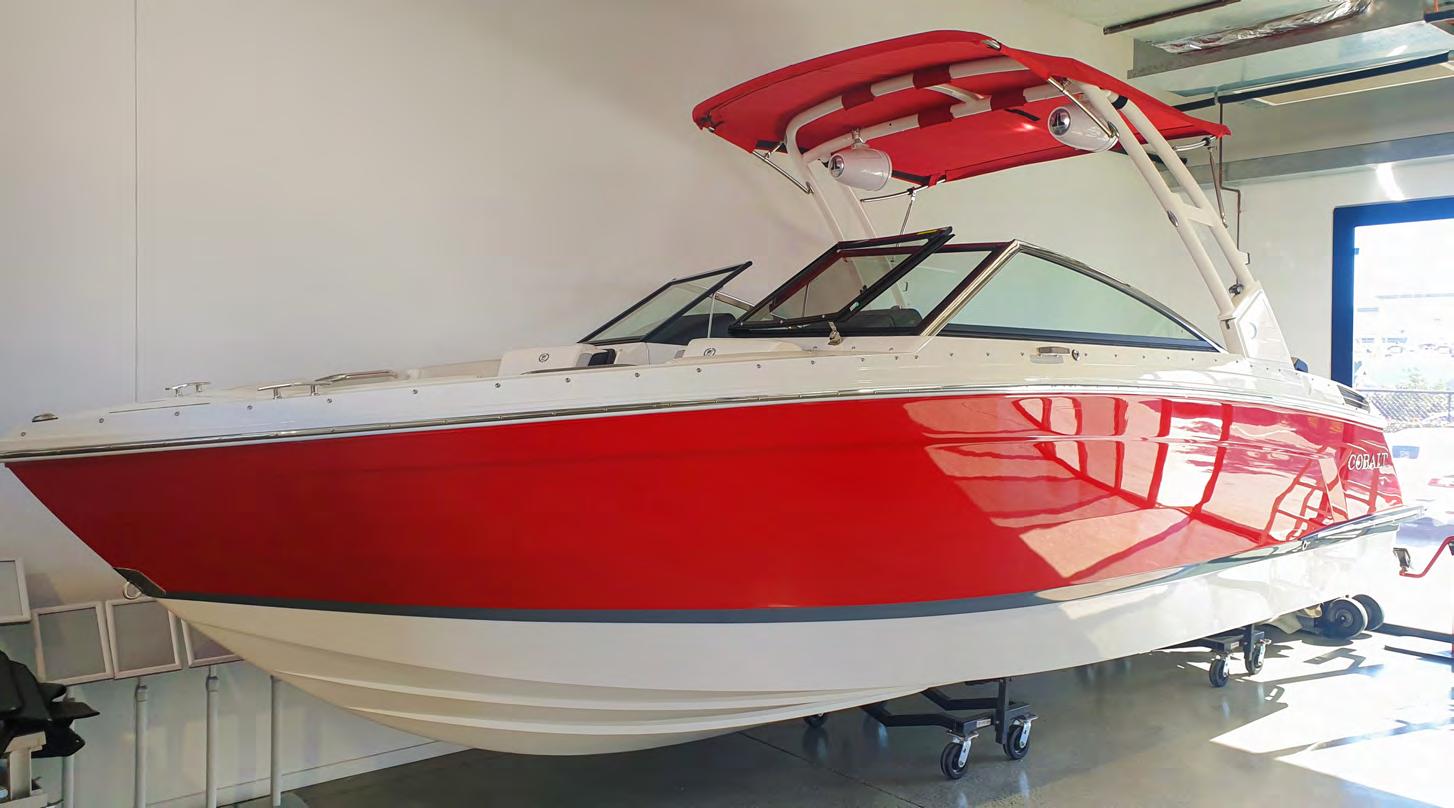
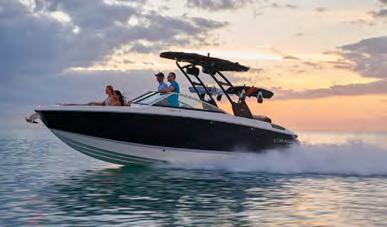
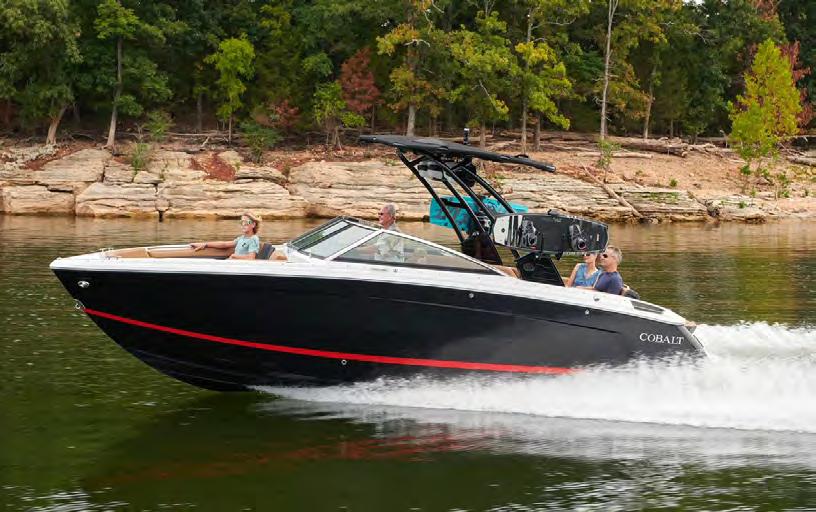
Shade Options
FOR YOUR BOAT
By Dianne Katra
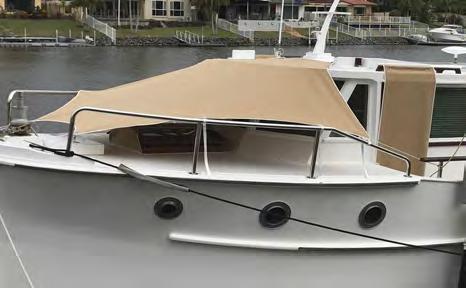
With the sun seemingly ever hotter and more damaging, many boat owners are asking what they can do to protect both their boat and their guests. These are just some of the popular options available to you from a marine trimming perspective.
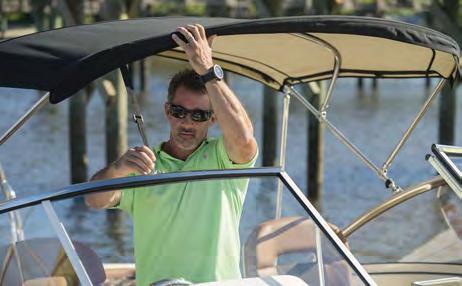
BIMINI TOPS AND AWNINGS - First up is keeping the sun off your head. A good bimini top or awning can go a long way towards making your boating adventures more sun safe and fun for all your family and friends. There are many off the shelf biminis on the market, but often it is necessary to have one custom made to ensure it can provide the coverage you need. From there, the decision is whether to use aluminium or stainless steel. This depends on the speed of your boat and how you use it. If you have the type of boat that goes less than 20 knots, you should be fine with an aluminium frame, but make sure the aluminium has a 3mm wall for strength. If it’s likely you will go above 20 knots then a stainless frame is the way to go as it has superior strength. You have the options of Sunbrella, Mariner, Stamoid, Weathermax, and more to cover your bimini. The size of your bimini is up to you – the more coverage the better, but not if it gets in the way of casting a fishing rod! Also, keep in mind that the higher your bimini, the less coverage you get so try to find a balance that you are comfortable with. As far as coverage goes, in general, a metre between bows is ideal – so a three-bow bimini will get you two metres of coverage bow to stern, a four-bow, three metres, etc. Most boats won't encounter issues with the bimini width, but if your boat is over three metres wide, you may need to consider an awning. If you do have a larger boat or just want more coverage, you may need to look at an awning type frame. This will nearly always be stainless steel and of course be on the more expensive side, but they can be made to any size. They can also be designed with aesthetics in mind to produce something that not only protects you, but looks great too. Awnings can also be used as extensions from the rear floors of flybridges and from hard tops, to extend shade into the back deck area. Again, these will almost always be stainless and custom made. MESH SCREENS - Mesh screens are becoming more and more popular with boaties and can be extremely versatile. You have the choice of breezeway style meshes (60 to 75% blockout) and “closed” meshes (90 to 95% blockout).
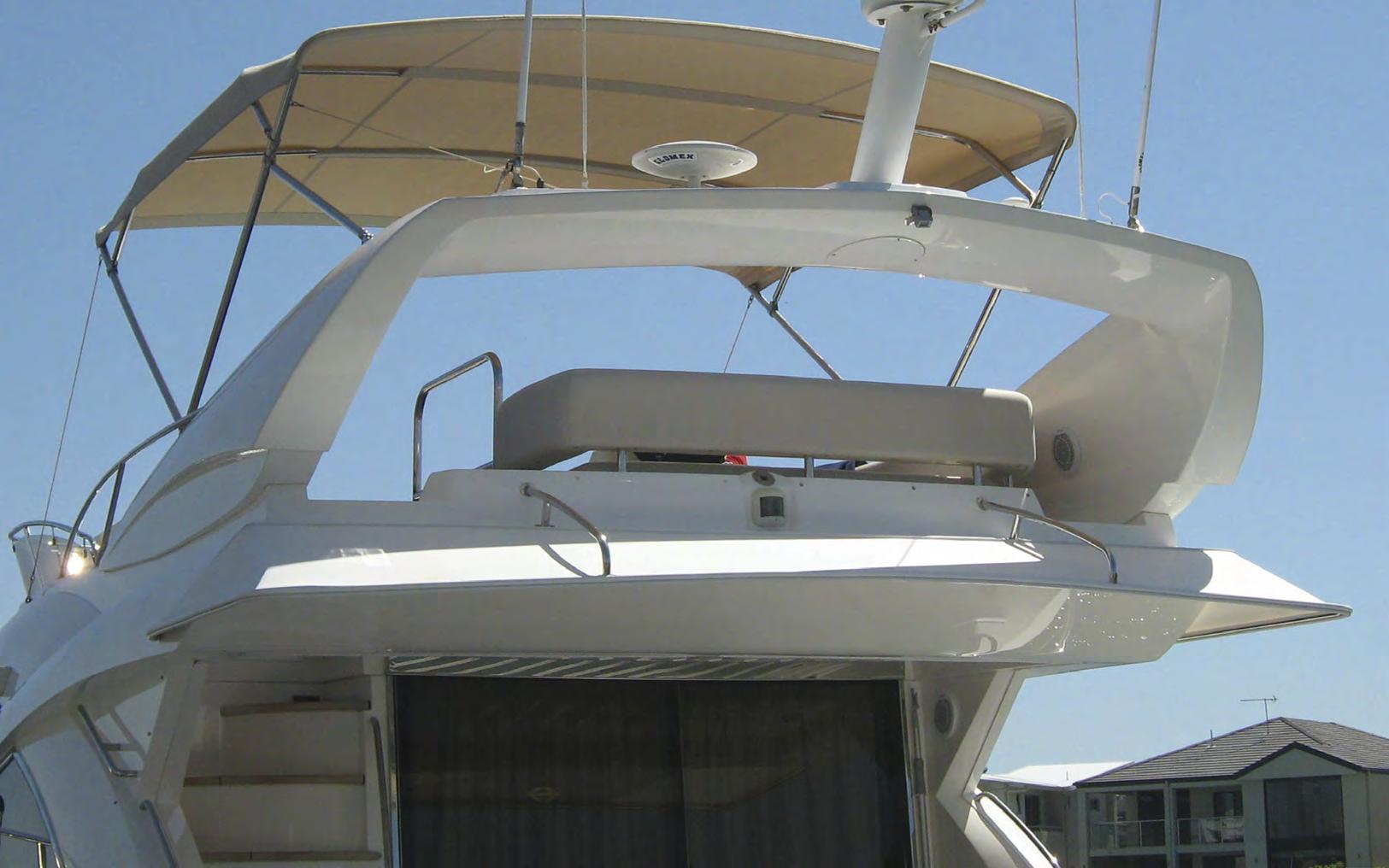
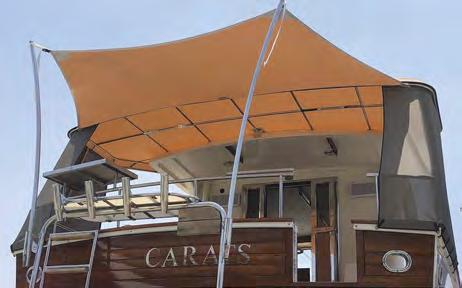
Popular Sunbrella covers for biminis and awnings

Mesh screens for ventilation and midges
Breezeway style meshes are ideal where you want some sun and heat protection, but you do not want to reduce airflow too much. This mesh is also good mosquito protection, but is not midge proof. It is also easy to see through, although using it in driving positions at night is not recommended. So think about using this around the back deck of your boat, and around your windows to reduce heat and light into the interior of your boat and in covers to allow airflow. Closed mesh provides that higher level of sun protection. It blocks out up to 95% of the heat and light into an area, but is still able to be seen through so you don’t feel closed in. It offers very good mosquito, midge and wind protection and does offer some protection from rain. The Vistaweave collection also offers a large colour range, which provides plenty of choice and compliments many of the Sunbrella colours.
Blockout covers for protection
BLOCKOUT COVERS - The highest level of protection for your boat’s interior, and of course for you too, are solid covers. Many boaties are choosing solid covers around their cabin windows, hatches and rear decks to protect timberwork, teak and upholstery from sun damage. The downside is, of course, that you can’t see through it, but it certainly works in many applications.
EURO COVERS - These are covers that generally attach to an existing hard top, bimini or flybridge floor, and extend out to stainless steel poles to provide temporary sun cover. The poles can be curved to assist with tensioning and to provide greater shade coverage. While these structures cannot be kept up permanently (or while driving) they do offer a flexible option to provide more sun protection for you and your guests on those hot, sunny days.
www.classicmarine.com.au
Euro covers for sun shade

INGREDIENTS FOR THE PERFECT REFIT EXPERIENCE
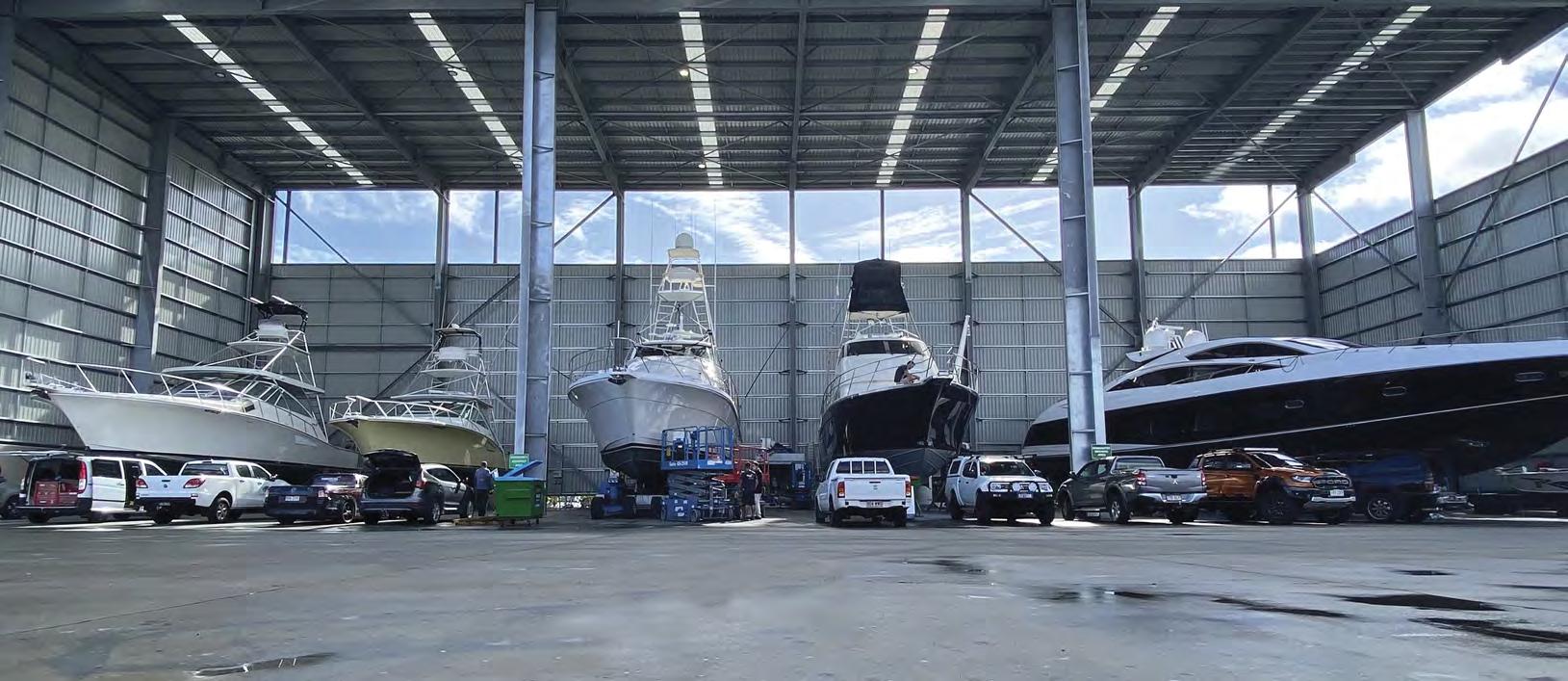
No matter what type of vessel, large or small, embarking on a refit is inevitably a challenge. There are many different answers when it comes to determining what makes or breaks the experience. One thing for certain though; communication is king. Planning may seem like the single most important aspect, but any great plan will fall apart completely if it lacks the proper communication. “[A refit] can’t be described as perfect,” says Kevin Altera, General Manager of Operations and Business Development at Gold Coast City Marina & Shipyard (GCCM). “It’s about managing expectations and keeping the job on track, and it all comes down to communication.” With thirty years of senior management experience in the marine industry and global experience in superyacht construction and project management, Altera has learned first-hand what keeps a refit from going ‘pear-shaped.’
“Reactive management will never work,” says Altera. “You need to be proactive all the time.” One of the first steps in creating a proactive refit plan is establishing the scope of works. Choosing a shipyard and trades which will work together and fully grasp the project as a whole to keep it all running smoothly. With over 90 individual marine business on site, gathering quotes for a wide range of works is extremely easy to do at GCCM. Superyachts, sailing, cruising and game fishing vessels all offer their own challenges when it comes to a refit. GCCM has mitigated all of them with an unrivalled array of leading contractors representing every conceivable marine trade and service.
Having all the trades in one area is massively important to the refit process but the facility itself is also key in how efficiently the project moves forward. The GCCM facility is designed to make the refit process as simple and smooth as possible. The facilities and capabiliites are unrivalled with a 300 and 50 tonne travelift, 19-metre clear height undercover work bays, refit sheds for yachts up to 50-metres, a dedicated keel pit and berthing for yachts up to 75-metres allowing for in-water work.
Hardstand works are typically the most cost effective way to complete a wide range of works but it leaves your vessel exposed to the elements, and Mother Nature can derail even the most perfect timeline in a split second. The new undercover hardstand at GCCM diminishes the risk of weather delays and helps keep your project on track. The 19 metre high shed is perfectly designed for game fishing vessels with tall towers, sailing yachts with large masts, and so much more. Anything that may need to be done on a hardstand can be done much more efficiently undercover. Sailing vessels, feel at home with GCCM’s keel pit making hardstand works easier and more safe. Not to mention the numerous trades tailored to specific vessels. Graham (Scooter) Eaton and Australian Marine Enterprises (AME) specialize in a large range of refits but are known for their expertise in sailing vessels. Steve Jackson from Sail Inc is one of Australia’s most experienced sail makers and works side by side with master rigger Jason Cowling from JCMS. Each business onsite at GCCM is a master of their craft and stands by their work meaning you will always be in good hands anywhere in the shipyard. Returning GCCM customers, Colin and Penny have project managed two of their own refits. Last year their refit spanned over 5 months involving a great number of trades and most recently, Aroha, with a much smaller refit only taking three weeks.
“It’s like coming home here for us,” said Colin.
“That’s why we come back. We’ve had really good experiences.” Both Colin and Penny cannot stress enough the importance of lining up the trades prior to arriving at the shipyard. Especially now with the current pandemic affecting order times and the general increase in demand for the marine trades. “You need to have all your ducks in a row,” said Colin. So, when planning out any vessels refit, communicate the scope of work properly from the very start and have a realistic timeline. Sourcing a facility that can accommodate your vessel, provide a number of reliable marine trades, and offer assistance in project management if needed, should be held high above the rest. GCCM and their award winning facility are sure to keep your refit on track and the grey hairs at bay.

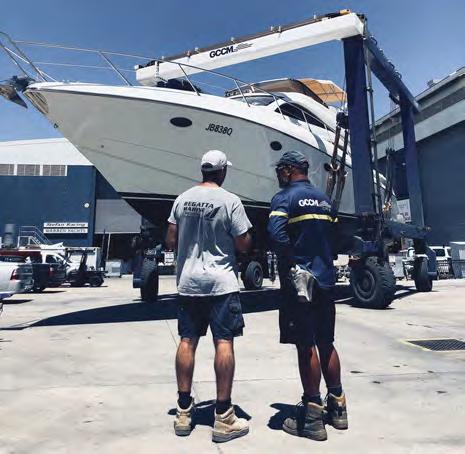
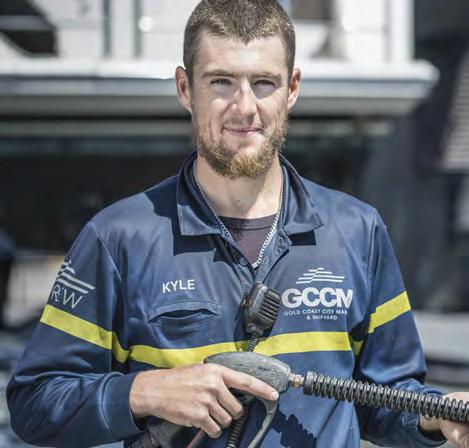
ESSENTIAL STEPS FOR A SPOT ON REFIT PROJECT • Determine the scope of works, budget, and timeline in advance • Determine if the project requires a professional
Project Manager or can be self managed • Determine your contingency for time and budget: surprises will come up and being prepared in budget and time frame will ease a significant amount of stress • Book your trades prior to booking the shipyard • Order parts in advance so they arrive on time • Develop a running and open dialogue with everyone involved. • Have trades come and look over the vessel prior to haul out if possible • Choose a shipyard that either has all the trades in one place OR a shipyard that is easily accessible for everyone involved in the refit. Discover more about GCCM at www.gccm.com.au

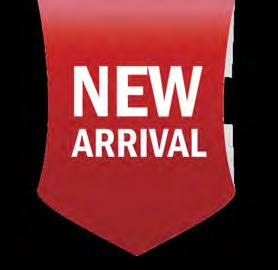
ISLAND GYPSY 500
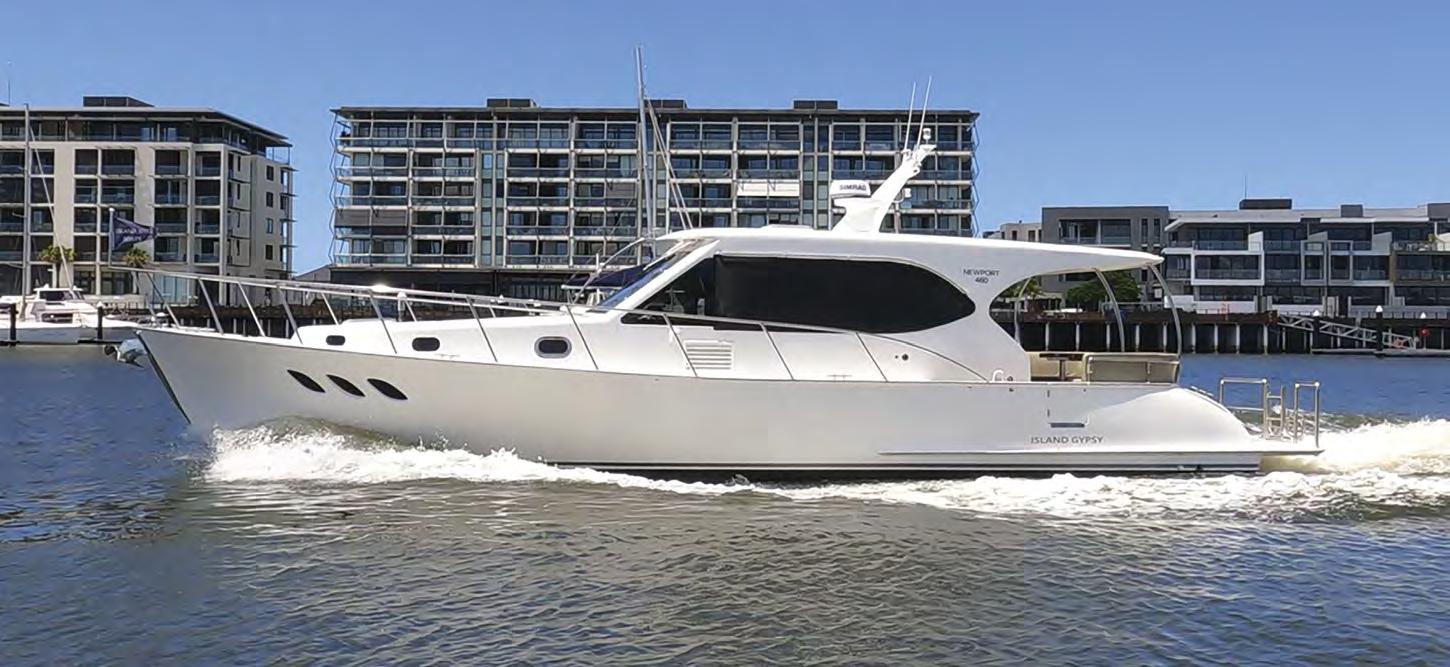
Twin Cabin - Twin Bathroom Luxury Cruiser
Marked by traditional lines, tremendous interior volume and smart functionality, the latest model in the Island Gypsy range is about to grace our shores. The Island Gypsy 500 is a natural progression following on from the popular 400 and 460 models, combining all the luxury and practicality of the brand on a grand scale. The 500 offers twin cabins, including a master with ensuite bathroom plus all the luxurious appointments boat owners have come to expect from Island Gypsy. It features wide walk around decks, a huge all weather aft deck and oversized swim platform, wrap around windows to allow ample natural light, a beautifully appointed galley with plenty of bench space, and storage and dual under bench refrigerators/ freezers. Owners and guests are treated to two forward staterooms, including a mid ship double with adjacent bathroom as well as a deluxe owner’s cabin forward featuring a separate shower room and head. The newly designed helm is complete with the latest electronics, which can be customised to the owner's specification and includes twin seating as well as a sliding helm door for quick access to the deck when docking. Powered by a single Cummins 660hp QSM11 engine running through a stateof-the-art Python drive system, allowing whisper quiet operation underway, with twin 1000lt fuel tanks and 1000lt of water, this Island Gypsy 500 has the range to take you to the most secluded anchorages. As with the entire Island Gypsy range, you have the ability to customise the interior furnishings to your preference and style. To date, 4 Island Gypsy 460 models have been sold and delivered as well as 5 Island Gypsy 400s with a further 7 sold and under construction for our discerning clients. The boats international brokerage division has experienced unprecedented demand over the past 12 months. They have many past and new clients eager to get into a boat for the summer. If you are considering selling or upgrading, please contact the crew at Boats International who pride themselves on outstanding customer service, expert industry knowledge, along with a reputation for achieving the very best results for clients. Whether you’re buying or selling, drop in and visit our on-water display Pier “H” Gold Coast City Marina, 7 days a week, or call Paul 0421 859 273, Grant 0402 811 175 or John Silsby 0420 716 713.
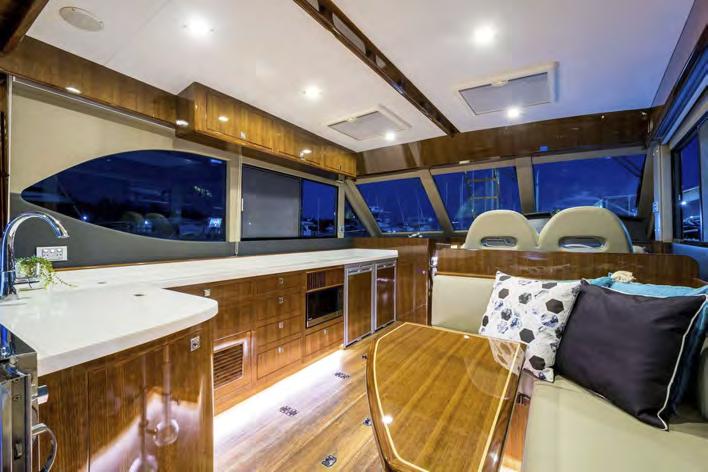
More at www.boatsinternational.com.au
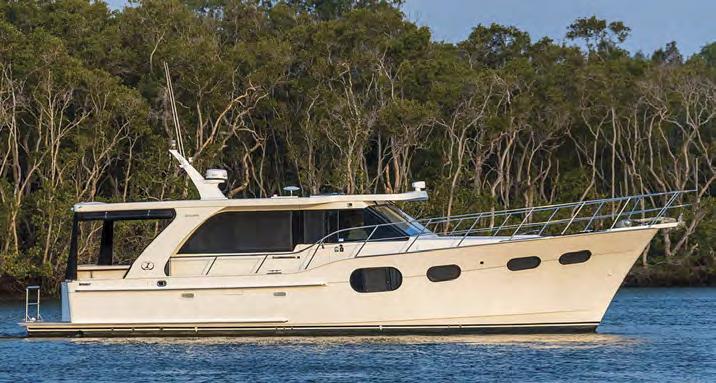
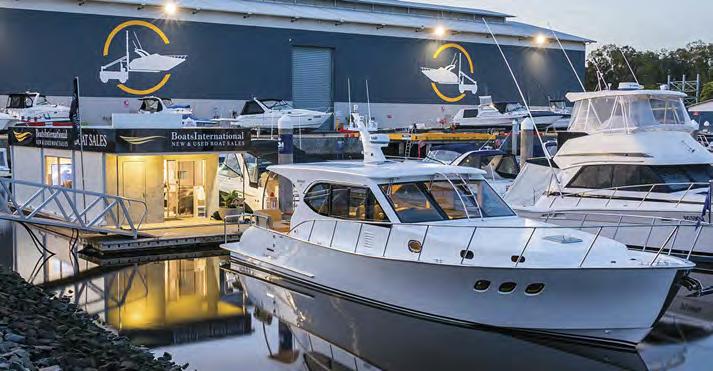
Example of interior options

WANTED
BROKERAGE BOATS



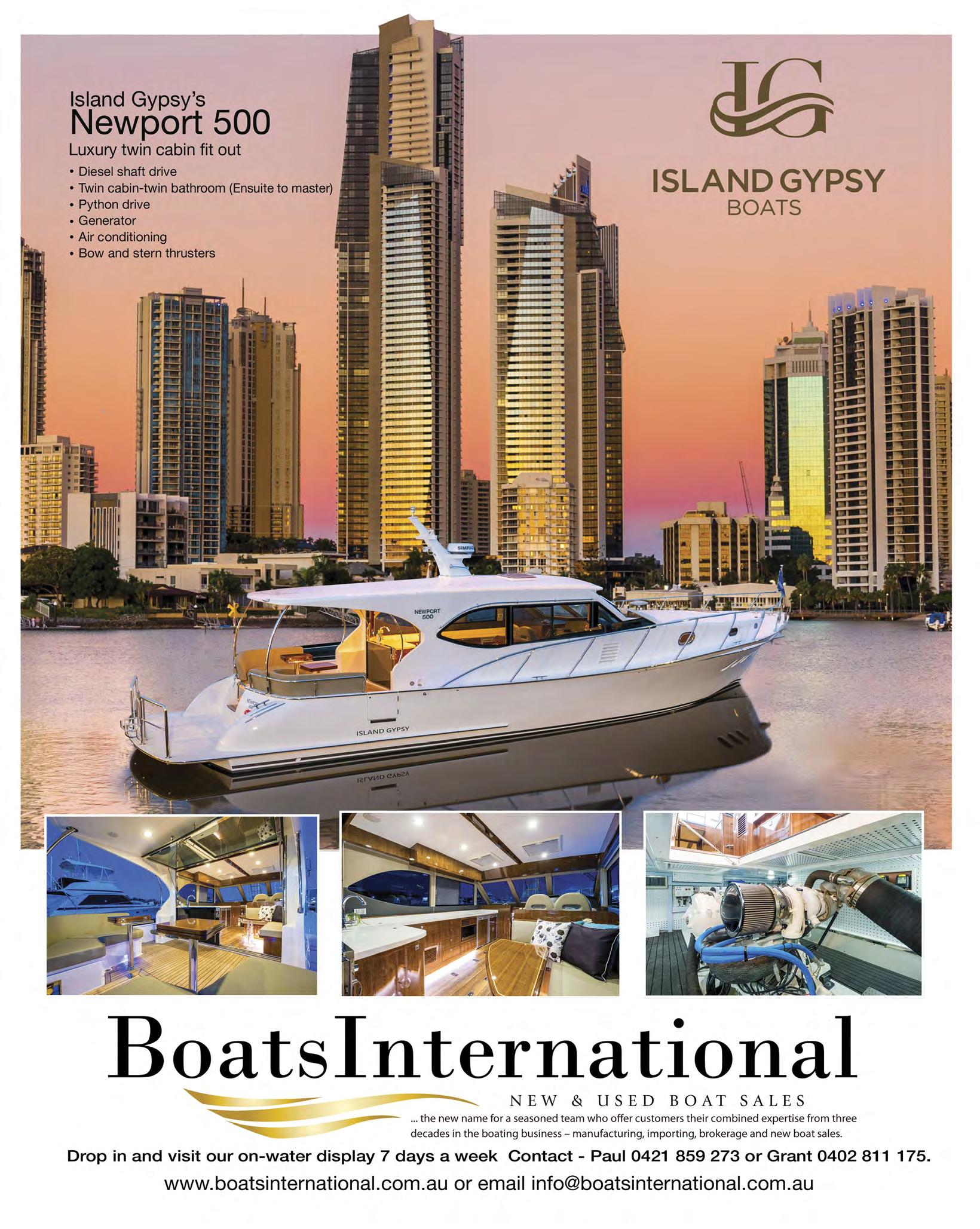
Trade Enquiries Welcome
PREMIUM CERAMIC COATINGS
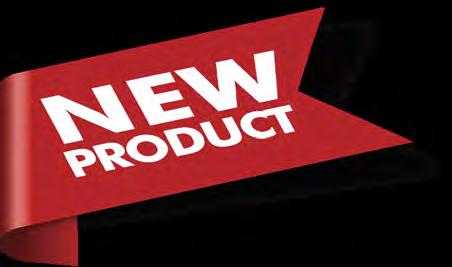
EXCELLENT GLOSS AND DURABILITY

HABOURFORCE MARINE is proud to introduce a new line of Premium Ceramic Coatings – FORCE ONE Durable Sealant and FORCE TWO Ceramic Clearcoat. Ideal for small boats to superyachts.
Ceramic coatings offer excellent gloss and durability and are a great solution to protect a boat’s surface from the harshness of the elements, repelling UV rays and not allowing penetration by salt and acid rain. When a boat is treated with a ceramic coating, invisible nanoparticles seal all pores in the surface, and it becomes hydrophobic – repelling water. Problematic diesel soot and black streaks can be easily washed off simply by using soap and water, without scrubbing away at your expensive paintwork.
CERAMIC COATINGS COME IN TWO VARIETIES:
Force One is a premium-quality durable sealant. It has exceptional easy clean properties and gives a durable long-lasting shine. Force One can help you stretch the time between paintjobs and makes even veteran paint surfaces look fabulous. Force One is an easy-to-apply sealant. While it provides a deep gloss it also maintains the original appearance of paintwork. Force Two is our premium ceramic clearcoat. It is a much thicker coating than Force One, while providing the same deep gloss and easy clean properties. Force Two is exceptionally durable, and is ideal for high traffic areas, and less accessible areas also. Force Two is an exceptional application for waterlines, transom doors and hulls. It makes water lines simple to clean up for diesel soot, oils, and tea staining (discolouration of stainless steel). Force Two is also great at protecting dark hull colours from sunscreen staining. Chemicals contained in some sunscreens can permanently mark dark hulls and Force Two is an effective solution to prevent this common staining problem.
REMOVAL: FORCE ONE can be removed, after application, merely by polishing.
FORCE TWO is easily and simply removed, without damaging the foundation paintwork underneath, by using a removal gel. BOAT CLEANING - HULL DETAILING - ANTIFOUL Harbourforce offers a range of interior and exterior boat services to maintain the condition of your vessel, such as machine cut and polishing, scheduled washdowns, carpet cleaning, mould removal, stainless steel polishing, teak rejuvenation, gelcoat repairs and antifoul. One of the foremost aspects of boat maintenance is the protection of and proper care for a vessel’s gelcoat – the ‘outer-skin’ of your vessel. Cracks, worn out or scratched gelcoat, are a consequence of not taking care of the gelcoat, potentially leading to moisture infiltration in the underlying fibreglass, resulting in serious and costly damage. Educating boat owners in protective gelcoat measures is crucial at Harbourforce, so here are our top 5 tips: 1. Use marine grade products only. 2. Thoroughly machine-compound the vessel before wax application. 3. Use marine-grade wax (acts as sunscreen against harsh conditions). 4. Have a consistent waxing regime – reapplying every 4-6 months. 5. Regularly wash-down the vessel.


